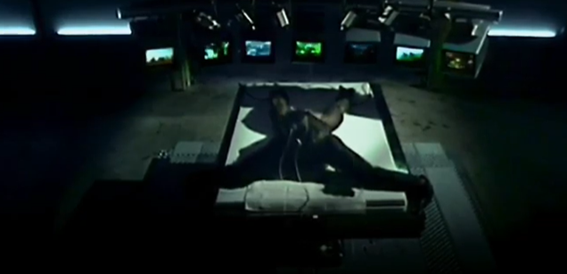Boyle’s 28 Days Later presents a devastated post-apocalyptic world in which a highly infectious rage virus spreads through humanity, causing those infected to be struck with mindless violent rage. The opening laboratory scene depicts the origin of the virus and moment the infection is first transmitted to humans. The spread to humans happens through chimpanzees infected with the virus being released by an animal rights group. The chimpanzees inhabit the role of a research subject within this scene, they are bound, caged and are unable to have any control over their environment. Although it is the chimps that cause of the outbreak and initial spread of the virus to humans, it is only through human scientific intervention that the chimps are infected in the first place. There are two distinct oppositions in the human animal relationships present within this scene. The scientists inhabit the role of exploiter and view the chimps as only experimental subjects for research, whereas the animal rights group attempt to inhabit the role of liberator of the chimps and want to free them from their cruel treatment and confinement .
The scene opens with grainy footage portraying different forms of human violence and chaos, quickly cut together displaying: fighting, rioting, and killing. The sound of news reports merges together with screaming and static, this fades into a rhythmic white noise as the shot zooms out on the screens. As the tracking shot zooms out, the prone form of a chimpanzee becomes visible. Boyle utilises the culmination of the bright flashing screens cutting between different scenes of violence and the sounds of static and screams to present the claustrophobic and unnatural environment the chimpanzee is being subjected too is. This reiterates to the viewer the Chimpanzee’s lack of choice or agency, it is being subjected to this environment by the scientists. Furthermore, the tracking shot looking over the screens showing suggests that this rage virus isn’t needed to cause humans to engage with acts of mindless violence and killing, it is already an aspect of humanity.


The chimp within this scene is a spectator to the human violence playing out before it and is taught mindless rage through watching humans. Subverting the perceived notion of human civility and chimps being viewed as a more violent and unpredictable species. The concept of human exceptionalism is also put into stark reality, as the chimp watches mobs of humans mindlessly destroying, maiming, and killing. The idea of humans being superior to other animals due to evolutionary, cultural, and technological advances is put into question for the viewers as Boyle presents these cases of human savagery. The wide angle shot from the back of the chimp shows that it is restrained to a bed with wires attached to its head highlighting the chimp’s role as an involuntary participant in this research. The scientists have physically retrained this chimp removing its autonomy which further highlights the barbarity of the human species, the only movement the chimp is enabled is that of its head moving over the screens, watching, and learning. The combination of the flashing screens, disconnected audio and the physical restraints further heightens the feeling of the chimp’s entrapment to the viewer.

A group of humans enter the scene in the form of CCTV footage, this intermedia element breaks up the narrative of the scene, reinforcing to the viewer the highly monitored and cold scientific space of the laboratory. As they enter the lab the distressed sound of chimps screeching breaks through the white noise clearly presenting their discomfort at their surroundings and confinement. In the wide angle shot the three humans are in the background and in the foreground is a partially dissected chimp cadaver, presenting the chimpanzees’ position as exploited test subjects for the benefit of humanity, they are an expendable commodity within this scientific setting. Furthermore, the dissected chimp presents to the viewer that these chimps are exploited even after death. As the humans move further into the laboratory, a wide angle shot shows rows of glass cages with chimps in. Boyle shows the that these chimps are an expendable collective to the scientists, their agency and welfare isn’t considered as the caged chimps make screeching sounds of distress. Boyle uses Chimpanzees within this scene as they are the closest relative to humans, therefore it makes sense to the viewer that the rage virus mutates to humans. The use of chimpanzees within this scene also reiterates the scientists’ cruelty as they are prepared to encage, kill, and dissect animals capable of complex emotional states and that so closely resemble humans. As the group of animal rights activists look around, they are horrified as they survey the treatment of the caged chimps before them, one states ‘’fucking hell’’ vocalising the groups shock. These humans unlike the scientists don’t view the chimps as disposable test subjects, instead they are visibly horrified by their treatment and want to free them. This group aim to inhabit the role of protector to the chimps rather than the exploiter of them.

